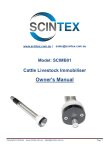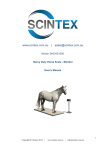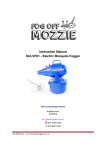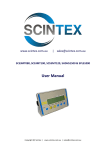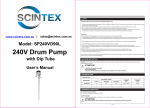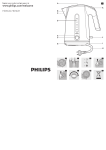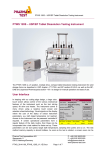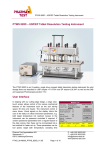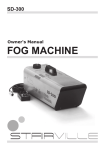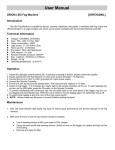Download Industrial Thermal Fogger
Transcript
www.mosquitofogger.com.au Model: SITF01 Industrial Thermal Fogger User’s Manual Available from: www.scintex.com.au Ph: | (07) 3137 0135 | Scintex [email protected] Fax: (07) 3041 0541 1 Copyright (C) Scintex 2014 | www.scintex.com.au | [email protected] WARNING: Please read the manual before operating the thermal fogger. This fogger will have extremely hot components when at operating temperature. BE VERY CAREFUL TO PREVENT BURNS. This thermal fogger is powered by unleaded fuel. Always keep clear of possible sources of ignition. When not in use store the fogger in a cool dry location. HEAT!!!! WARNING WHEN OPERATING THIS FOGGER WILL HAVE VERY HOT SURFACES. DO NOT TOUCH THE BLOWER OUTLET, PROTECTIVE GUARDS OR CARBURETOR WHILE HOT. Technical Parameters Specification Value Chemical Tank Volume 5.2 L Fuel Consumption ~1 L/hr Fuel Tank Size 1.1 L Net Weight 8.8 kg Fuel Required Unleaded 90+ Spray Volume Up to 20L / hr Ignition Power 2x 1.5V D Batteries Dimensions 1200 x 285 x 338 mm 2 Copyright (C) Scintex 2014 | www.scintex.com.au | [email protected] Structural Diagram Figure 1.0 & Table 1.0 Number 1 2 3 4 5 6 7 8 9 10 Description Cleaning Bolt (accumulated carbon on nozzle) Long Chemical Line Chemical Supply Valve Throttle Connector Shut Off Button Chemical Drain Plug Chemical Tank Throttle Adjusting Bolt Carburetor Cleaning Bolt Fuel Tank 3 Copyright (C) Scintex 2014 | www.scintex.com.au | [email protected] Figure 2.0 Piping Diagram Figure 3.0 Circuit Diagram 4 Copyright (C) Scintex 2014 | www.scintex.com.au | [email protected] Figure 4.0 Carburetor Assembly Performance Features Simple, light weight & mobile, high fog discharge and safe! No rotary engine parts or friction components to wear out. Also reduces the weight of the fogger. Limited service or maintenance required. Simple and reliable electronic circuits. Variable chemical delivery. 5 Copyright (C) Scintex 2014 | www.scintex.com.au | [email protected] Preparation Before Use Battery Installation: 1) Remove battery cap retaining screws. 2) Fit batteries (2x 1.5V D Batteries) paying particular attention to the positive and negative symbols. 3) Replace battery cap and retaining screws. Filling with Fuel: 1) Remove fuel cap 2) Fill with 900mL of 90+ Octane fuel which has been filtered. If the fuel is dirty it is highly likely the carburetor will become blocked. 3) Replace cap and ensure a good seal Note: Do not overfill Filling with Chemical: Note: Diesel or diesel oil is the recommended carrier. Make sure any chemicals or fluids used have been filtered to avoid blockages. 1) Turn the chemical supply valve to OFF. 2) Mix your chemical / carrier solution in the desired ratio. 3) Fill the tank with your mixed chemical, for best result do not fill more than 3.5L. 4) Replace the chemical tank cap and ensure it seals correctly. Do not over tighten as you will damage the seal. Operating the Fogger Starting the machine: Note: Do not attempt to start or operate the fogger in environments where flammables, explosives or sparks exist. Make sure when starting the machine the nozzle or blower outlet is not facing anyone or valuables. 1) Close the chemical supply valve. 2) Switch the power ON. Listen for the spark. 3) Pump the pneumatic cylinder handle several times with a slow and fluid motion. Refrain from over pumping or pumping quickly as this will flood the carburetor and prevent ignition. 4) After the fogger starts, turn the power switch to OFF. Adjusting the throttle position: Note: The throttle has been factory set to allow ease of starting. Only adjust this if you are unable to start the fogger with the current setting. 1) Locate the throttle adjusting screw, it has the "-" on its end. It is fastened with a hexagonal lock nut. 6 Copyright (C) Scintex 2014 | www.scintex.com.au | [email protected] 2) Loosen the lock nut to allow the screw to be adjusted. 3) Adjust the throttle position as required. Clockwise turn will reduce the throttle opening. Counter Clockwise will increase the throttle opening. 4) Use only small adjustments, 20o or less at a time. 5) When you have the throttle position required tighten the lock nut. Chemical fogging: 1) After starting the fogger allow it to warm up for 1-2 minutes. 2) When you wish to start fogging simply open the Chemical supply valve and the tank will be pressurised and chemical will start to flow. 3) To stop fogging close the chemical supply valve. Turning off the fogger: Note: If you only want to stop fogging for a short period it is acceptable to turn the chemical supply valve off and leave the fogger running. However, do not leave a running fogger unattended. If the fogger flames out while in use make sure to immediately close the chemical supply valve. 1) Close the chemical supply valve. Wait until no more fog/mist is coming from the fogger. 2) Close the throttle by pressing the Shut Off button on top of the carburetor for several seconds or until flame out occurs. This will starve the carburetor of fuel. Keep the button depressed for several more seconds to remove pressure from the fuel tank. 3) Open the chemical tank cap to discharge any pressure. Maintenance Storage: If you will not be using the machine for some time it is advised you remove any chemicals or fuel from their tanks. Inspect the tanks for any dirt or impurities and flush if necessary. Remove the batteries from the fogger. Store the fogger in a cool, dry place away from the elements. Removing carbon build up: Check the following and clean as necessary: 1) Spark plug. Also check the spark plug gap. 2) Main fogging pipe. 3) Spraying nozzle Fixing Leaks: If during the period of use or operation any fuel, chemical or air leaks were discovered note their location. It is likely you will need to replace the seals, gasket or hose associated with that component. The fogger kit is supplied with many of the necessary seals, one way valves and tools required to perform these replacements. 7 Copyright (C) Scintex 2014 | www.scintex.com.au | [email protected] Trouble Shooting 1) No detonation while starting the fogger 1.1) No Spark (No igniting sound from spark plug) a) Loose Connections - Check connections of wires and joints. Check contact of spark plug boot. b) On Off Switch Fault - Replace switch c) Low Battery - Replace batteries d) Batteries inserted incorrectly - Refit batteries. e) Wet Spark Plug - Remove fuel, oil, chemical or carbon in contact with the spark plug. f) Ignition Coil Fault - Replace coil 1.2) No Fuel Supply a) Fuel Tank empty or too low - Fill Fuel Tank b) Air leak in fuel tank cap - refit properly or replace seal c) Fuel Lines blocked - blow lines clear or replace hosing 1.3) Throttle Not Tuned a) Throttle opening too big or small - Adjust throttle position with throttle adjusting bolt 2) Detonation occurs but fogger will not run continuously 2.1) Unclean Fuel a) Water or impurities in fuel - Change fuel. 2.2) Weak Spark a) Low Battery Voltage - Replace batteries. 2.3) Flooded carburetor a) Throttle opening too large - Reduce throttle opening. b) Pumping the pneumatic cylinder too fast or for too long - Wait for fuel to evaporate from carburetor and spark plug. Use a slow, continuous motion with the handle. 2.4) Bubbles in fuel lines a) Loose Fuel Pipe Joints - Find and tighten. b) Bubbles from refilling fuel - Turn power switch on, pull and pump the pneumatic cylinder handle to remove bubbles. c) Broken fuel line - Replace. 2.5) Air leak a) Air inlet diaphragm not sealed or broken - Level the diaphragm or replace. b) Loose carburetor flange, spark plug socket or petrol tank cap - Fasten screws or replace seals where necessary. 3) Fogger runs but is not stable 8 Copyright (C) Scintex 2014 | www.scintex.com.au | [email protected] 3.1) Blocked fuel lines a) Dirt or debris in fuel - Replace fuel and flush lines. 3.2) Low power and ease of flame out a) Poor fuel - Replace with clean fuel and flush system b) Fuel line leak - Check lines and replace as necessary c) Throttle position not tuned - Adjust throttle opening until the fogger has more power and stability in the flame. d) Air leak - Check all lines, joints and caps for possible leaks. Replace seals or lines where necessary. e) Carbon accumulation in spraying pipe or fume pipe - Clean and remove carbon. 4) Sudden flame out a) Fuel has run out - Refill fuel. b) Blocked fuel line - Inspect lines and blow out or flush where needed. c) Air bubbles in fuel lines - Check for air leaks and fix. See 2.4. d) Too little or too much fuel - Adjust throttle position. 5) No mist or fog produced a) Low chemical tank pressure - Chemical tank cap is loose, tighten or replace seal. b) Leak in chemical lines - Check lines and joints, tighten or replace where needed. c) Blocked main pipe - Check main pipe for dirt, nests etc and clean when cool. d) One way air valve faulty - Check the one way air valve for blockages or faults. Clean or replace. e) Blockage in spray head or filter net - Check and clean. 6) Very little fog produced 6.1) Low chemical tank pressure a) Air leak in cap - refit or replace seal. b) Air / Chemical line broken - check and replace. c) One way valve blocked or broken - check, clean or replace. 6.2) Blocked Chemical Pipe a) Blocked pipe - Clean or replace. b) Carbon build up on chemical spray nozzle - Clean nozzle. 6.3) Reduced Power a) Too much carbon in the spray lines - Clean or replace. b) Throttle not tuned correctly - Adjust throttle opening. 7) "Flame Throwing" occurs during operation a) Fogger too hot - allow to rest at regular intervals if overheating is an issue. b) Too little chemical converted to fog/ mist - Increase flow with chemical supply valve. 9 Copyright (C) Scintex 2014 | www.scintex.com.au | [email protected]










